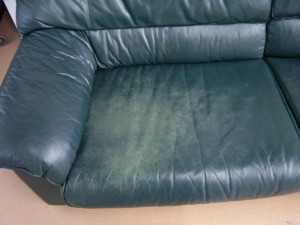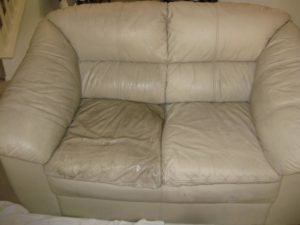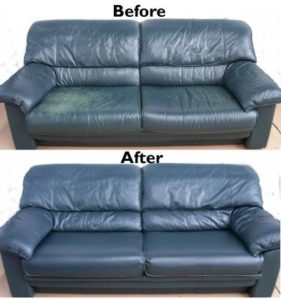How to prevent cracked leather furniture
To be totally honest, if aniline or semi-aniline upholstery leather cracks, it’s often too far gone to be worth repairing. Now, this is not always the case, but when these leathers crack, it’s usually the result of problems that have been neglected or unnoticed for a long, long time. Fully-finished leather is different, though. Check out another of our blog posts for explanations of the most common types of upholstery leather.
Cracking of fully-finished leather is actually a very common problem that leather restoration experts can easily fix, but like most things with leather furniture, it’s easier (and cheaper) to take care of the problem before it really becomes a problem.
Why does leather crack?
Our estimate is that 95% of cracking in fully-finished leather starts with one of these two culprits:
1. A manufacturer problem – To make fully-finished leather, manufacturers put a layer of dye and a protective top coating on the hide almost like paint goes on drywall. Leather has a lot of give and will stretch and move as people sit and slide around on it. If the manufacturer doesn’t stretch the leather properly before they put on the dye and protective top coating, the leather will quickly stretch more than the dye can handle, and the coating will crack.
2. Body oil and dirt – Leather is incredibly porous, and it soaks up oil whenever it touches it. Believe it or not, the most common source of these problems is you from your own bare arms, legs, neck and hair. Dirt also gets soaked into the top coating on leather as it gets worn down. As you sit, stand and move around, that dirt and oil becomes abrasive, and it breaks down surface dye which will eventually lead to visible cracks at the surface.
Prevent Leather from Cracking:
There are two key things you can do to prevent cracking of fully-finished leather.
1. Clean and protect leather 3 to 4 times a year. You get rid of the dirt and oil still sitting on the surface of your furniture when you clean it, preventing it from eventually soaking in. A good protection cream will fill in the gaps and spaces in the original top coat of your leather as it gets worn down. By filing those gaps with protection cream, you remove the possibility that they can be filled with dirt and oil later – sort of like putting out the fire before it starts.
2. Avoid exposure to excessive amounts of dirt and body oil. The fact of the matter is that if you use your leather furniture at all, it is going to be exposed to some body oil and some dirt and dust that simply come with the territory. But, you can limit the damage of normal wear and tear. You should avoid sleeping on your leather furniture regularly or sitting down if you come in sweaty and dirty from outside. Also, if you are wearing sunscreen or have greasy popcorn hands, use the less expensive seats in the house. It’s a good idea to try to cover your leather in areas that see a lot of dirt and oil if you can. Try tossing a blanket over the headrest of a leather recliner you know you are going to rest your head on frequently or for extended periods of time.
Repair Cracked Leather:
Once leather has been cracked, there isn’t much you can do for it yourself, but a professional can either re-dye it or replace parts of the piece, depending on the extent of the damage, to eliminate the problem.
Additional Questions?
We’d be happy to answer any additional questions you have. Please ask in the comments below! If you want to show us a photo of a specific piece of leather, either post it on our Facebook page or contact your local franchisee.



